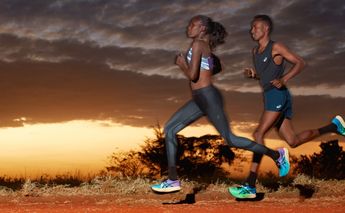Female-friendly shoes make running more fun for women.
While it's an obvious fact of nature that men and women are different, the realisation that they also run differently is not immediately so obvious. Until recently most running shoes for women were just smaller versions of men’s shoes. But as we come to understand the structural and hormonal differences between men and women, running shoes are fast becoming more female-friendly.
Over the past decade, scientific research has shown that women have different gait patterns and lower-limb biomechanics than men. This means that the way women run is significantly different, and it also helps explain why female runners have distinct injury patterns. ASICS is taking a gender-specific approach to designing running shoes, with the aim to improve women's performance, comfort and safety.
Foot Shape
To start with a simple example, women's feet are shaped differently. It's
not just that women tend to have smaller feet than men, they also have
a different heel to forefoot ratio. In other words, women have a narrower
heel in relation to their forefoot. When wearing men's running shoes, this
often causes the heel to slip inside the shoe, leading to instability and
chafing. Or, as some women try to solve this problem by buying narrower
shoes, it causes constriction and pain in the forefoot.

This familiar frustration for many female runners has been addressed by
ASICS by developing a gender-specific fit. ASICS women's shoes are shaped
differently, using a narrower last. A gender-specific last dramatically
improves fit for female runners and prevents problems like heel slippage.
Another ASICS technology that helps improve fit for women – and for men
too – is called Personal Heel Fit (PHF). Using a memory foam in the heel
lining, PHF moulds itself to the wearer's individual heel shape to create
a snug, non-irritant fit.
Bounce-back
A second basic gender difference is that women tend to be lighter than
men. One of the key functions of running shoes is to attenuate the impact
forces on the feet and legs. However, since cushioning in running shoes
has always been designed with men's weight in mind, the cushioning material
would often be too dense for women. As a result, women wouldn't fully compress
the material and benefit less from its bounce-back qualities.

ASICS has responded to this issue by developing Gender Specific Forefoot Cushioning. It uses a proprietary cushioning material called Solyte, but in a less dense form than its male counterpart. Located under the ball of the foot and extending across the width of the shoe, this material offers female runners greater impact absorption and more bounce. In short, Gender Specific Forefoot Cushioning makes running shoes a lot more comfortable for women to run in.
Gender & Gait
So far we have looked at structural gender differences, but there are
also significant hormonal differences between men and women. A pioneering
study by the University of Melbourne was recently
published in the
Journal of Applied Physiology. Exploring the effect of oestrogen on the stretchability of soft tissue,
it paved the way to major design changes in the ASICS range of gender-specific
running shoes
What the study has shown is that women's foot architecture changes as their oestrogen levels fluctuate during the month. Oestrogen is known to be a soft tissue relaxant, and one of the effects this has is to lower women's arch height. This in turn influences the biomechanics of the foot, and specifically the plantar fascia, a bundle of thick tissue which stretches down the length of the foot and is fundamental in stabilising the foot during gait. With each step, the plantar fascia tightens and stretches in what is known as the windlass mechanism.

ASICS has sought to design running shoes that work with this natural movement of the foot, resulting in a technology called the Space Trusstic System. Consisting of a strategically placed pocket of space between the Trusstic device and the layer of midsole under the foot arch, it allows the plantar fascia to press downward freely while maintaining support for the foot.
For women the Space Trusstic was altered to accommodate for a lowered
arch height, and give the plantar fascia sufficient space to develop tension
and assist windlass mechanics. The Gender Specific Space Trusstic provides
the female foot with the right levels of support and flexibility as it
moves through the gait cycle.
Female-friendly technologies like Gender Specific Space Trusstic and Gender
Specific Forefoot Cushioning are making running shoes more comfortable
and effective for women.



